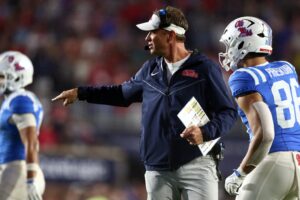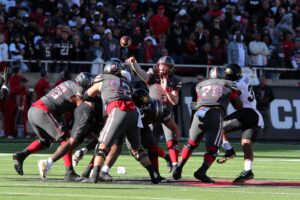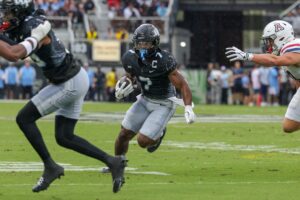A few weeks ago, we published an article concluding that Head Coach Dana Holgorsen has improved recruiting in Morgantown since he arrived. If a coach cannot guide that talent to play football at the next level, however, solid recruiting means little. Such a failure would no doubt curb future recruiting efforts. As a result, we look now at talent development under Coach Holgorsen. The goal is to determine how well he develops the talent he has attracted to Morgantown.
The Questions
We seek to answer two main questions. First, does Coach Holgorsen put more or less of his players into the NFL than average? Second, for those drafted, are those players selected higher or lower than the expected draft position based on their recruiting rank? The following data helps answer those questions.
- the average number of players included in the recruiting databases each year;
- the average number of players assigned each rank (five stars, four stars, three stars, two stars and below);
- the percentage of each designated rank that is ultimately drafted; and
- the average draft position for a player with each designation.
We do not seek to demonstrate which coaches draw the most talent to their respective programs. Recruiting class rankings already do that. We also do not compare which coaches or schools get the most wins over expected totals based on recruited talent. Although that is a topic worth exploring elsewhere. Instead, we simply want to know how well Holgorsen prepares the players he has coached for the NFL draft.
The Methodology
Defining the Data
We already know what averages and percentages we want, but how we get there is important. The relevant data must, of course, allow us to make fair and standardized comparisons to the extent possible. Thus, we need to focus on years where recruiting rankings are reliable and widespread. In 2001, for example, 247Sports only ranked 129 players. In 2002, however, that number climbs to 1,758, and it continues to climb thereafter. As a result, we have identified 2002 as the first year that reliable, widespread recruiting data is available. When determining the results-based averages, then, we will look at all draftees between 2006 and 2018, as the 2006 draft is the first draft in which most players drafted were assigned some rank during the relevant recruiting cycles.
Compiling the Average Data
We need two averages from these drafts. First, we want to know how many players from each ranking were drafted in average each year. Second, we want to collect the average round in which players from each rank were drafted. To standardize the numbers, the analysis uses the 247 Composite rankings, which average those of 247Sports, Rivals, and ESPN.
Based on these rankings and the relevant draft results, we know that, in 2018, 18 five-star recruits, 70 four-star recruits, 114 three-star recruits, and 54 two-star (and below) recruits were drafted. The recruits of each caliber were drafted in the following round on average: five-star recruits in the third round, four-star and three-star recruits in the fourth, and two-star recruits (and below) in the fifth.
Using these figures for each year, the average data between 2006 and 2018 follows.
| 5* | 4* | 3* | 2* (and below) | |
| Number Drafted(1) | 20 | 76 | 98 | 60 |
| Number Recruited(2) | 33 | 296 | 1590 | 1250 |
| Percentage of Total(3) | 61% | 26% | 6% | 2% |
| Average Draft Round(4) | 3rd | 4th | 5th | 5th |
(1) These figures represent the average number of each caliber of recruit drafted in a single year. For all purposes in this article, the two-star category also includes players who were unranked.
(2) These figures represent the average number of each caliber of player recruited during a single recruiting cycle.
(3) These figures represent the percentage of each caliber of recruit drafted during the period between 2006 and 2018.
(4) These figures represent the average draft round for each caliber of recruit between 2006 and 2018.
Compiling Coach-Specific Data
Standardizing results for numerous coaches presents a few hurdles. First, how do we account for Division one transfers? Unfortunately, a national database of such transfers has not been kept. As a result, unless a transfer was drafted, inbound Division one transfers are not used when determining the total number of players who played for each coach.
Second, historic rosters are hard to recreate. We seek to identify all players a coach recruited or coached during his tenure. This allows us to determine the percentage of each caliber of player that was drafted while having played his final season for a head coach. Unless we have a reliable way to accurately determine all players who played for a coach when he first began his tenure at his current school, then the percentages would be skewed higher and the results would be unreliable. Therefore, we analyze only those drafts that begin after a coach has enrolled his fourth recruiting cycle.
The lone exception is with Holgorsen. Based on the author’s familiarity with West Virginia football, particularly the immediate attrition and state of the roster when former Head Coach Bill Stewart was replaced by Holgorsen, the Mountaineer data does include players who played for Holgorsen during his first season as head coach.
The draftee information for all coaches continues through the 2018 NFL draft. And the recruit information for all coaches includes all players who either left their respective programs after signing a letter of intent or whose eligibility has fully expired. The article takes great care to ensure that numbers are not skewed either high or low by including, for example, players still on the active roster when calculating the drafted percentage of players of each rank.
Using the Data
Using the data compiled, we developed an analysis that focuses on three main numbers. It begins with the total number of rounds above or below the average draft position for each coach. For example, assume a coach has a total of four three-star recruits drafted during the relevant period. Assume those players were drafted in the second, fourth, fifth, and sixth round. Recall that the average draft position for a three-star recruit falls in the fifth round. The total raw score for those three draftees is three. To reduce the possibility that results are skewed too much by volume alone, the analysis averages that total number for each draft pick. In this example, the average score per draft pick is 0.75.
Second, the analysis uses the total number of percentage points above or below the total percentage of players drafted within each ranking designation. Using the example above, for instance, assuming the coach had twenty three-star recruits during the relevant time period, the hypothetical coach successfully placed 20% of his three-star recruits into the NFL. Recalling that the total percentage of three-stars placed into the NFL is 6%, this coach finished fourteen percentage points above the average.
The Final “Score”
Once the data produces the figures above, the analysis then assigns a total score to each coach. That score is simply the product of the two component parts. In the example above, the hypothetical coach averaged 0.75 rounds above anticipated for each draft pick, and the coach finished fourteen percentage points above the average. As a result, the coach has a total score of 11, which is rounded up from 10.5.
In chart form, the analysis works as follows:
| Player | Recruit Rank | Expected Draft Round | Actual Draft Round | Above/Below Expected |
| Pick 1 | 3* | 5 | 2 | +3 |
| Pick 2 | 3* | 5 | 4 | +1 |
| Pick 3 | 3* | 5 | 5 | 0 |
| Pick 3 | 3* | 5 | 6 | -1 |
| TOTAL +/- | +3 | |||
| AVERAGE (4 picks) | +0.75 |
| Rank | Total Drafted | Total Recruited | Actual % | Expected % | Above/Below Expected |
| 5* | 0 | 0 | N/A | 61% | N/A |
| 4* | 0 | 0 | N/A | 26% | N/A |
| 3* | 4 | 20 | 20% | 6% | 14 |
| 2* | 0 | 0 | N/A | 2% | N/A |
| TOTAL +/- | +14 |
Note: if a coach has a sum below zero for either component, the analysis assigns a score of zero to avoid a situation where a coach finishing with negative numbers for each component actually scores higher than a coach finishing with only a single component in the negative.
Talent Development under Coach Holgorsen
Using this methodology, Dana Holgorsen performs well, perhaps surprisingly well for some Mountaineer (and other college football) fans. Coach Holgorsen has entered 20 players into the NFL draft over his seven-year tenure that includes 2012 through 2018 drafts. Those players, their rankings, and their contributions to Holgorsen’s score follow.
| Player | Recruiting Rank | Expected Draft Rd | Actual Draft Rd | Above/Below Expected |
| Geno Smith | 4 | 4th | 2nd | +2 |
| Tavon Austin | 4 | 4th | 1st | +3 |
| Stedman Bailey | 3 | 5th | 3rd | +2 |
| Najee Goode | 2 | 5th | 5th | 0 |
| Keith Tandy | 3 | 5th | 6th | -1 |
| Bruce Irvin | 4 | 4th | 1st | +3 |
| Will Clarke | 2 | 5th | 3rd | +2 |
| Nick Kwiatkoski | 3 | 5th | 4th | +1 |
| Karl Joseph | 3 | 5th | 1st | +4 |
| Mark Glowinski | 3 | 5th | 4th | +1 |
| KJ Dillon | 3 | 5th | 5th | 0 |
| Shelton Gibson | 4 | 4th | 5th | -1 |
| Mario Alford | 3 | 5th | 7th | -2 |
| Wendell Smallwood | 3 | 5th | 5th | 0 |
| Daryl Worley | 3 | 5th | 3rd | +2 |
| Kevin White | 3 | 5th | 1st | +4 |
| Rasul Douglas | 4 | 4th | 3rd | +1 |
| Kyzir White | 4 | 4th | 5th | -1 |
| Charles Sims | 3 | 5th | 3rd | +2 |
| Shaquille Riddick | 0 | 5th | 5th | 0 |
| TOTAL | 22 | |||
| AVG (20 picks) | 1.10 |
Further, for each respective recruiting rank designation, Holgorsen’s draft percentages follow.
| Rank | Number Drafted | Total Players | Percentage | Expected Percentage | Above/Below |
| 5* | 0 | 0 | N/A | 61% | N/A |
| 4* | 6 | 14 | 43% | 26% | +17 |
| 3* | 11 | 103 | 11% | 6% | +5 |
| 2* | 3 | 29 | 10% | 2% | +8 |
| TOTAL | +30 |
Holgorsen performs well in both categories. As a result, his total score is 33.
Other Coaches vs. Coach Holgorsen
To see how well that number stacks up against other Power Five Conference programs, we used the same analysis to compile scores for several other head coaches. We chose coaches whose current tenures have produced at least three classes of NFL drafts for which full data is available. The two-component figures and total score for each coach follow.
The Numbers
| Coach | Average Above Expected | Percentage Above Expected | Total Score |
| Mike Gundy | 0.84 | 3 | 3 |
| Mark Dantonio | 0.58 | 48 | 28 |
| Nick Saban | 0.74 | 19 | 14 |
| Dabo Swinney | 0.46 | 26 | 12 |
| Bill Snyder | 0.40 | 17 | 7 |
| Brian Kelly | 0.86 | -41 | 0 |
| David Shaw | 1.00 | 42 | 42 |
| Urban Meyer | 1.73 | 49 | 85 |
The Conclusions
Surprised? Holgorsen finishes third overall and carries a significant advantage in this metric over very successful coaches. Coach Saban has an unexpectedly low margin above the average drafted. Dabo Swinney, on the other hand, tends to produce draft picks that more closely mirror their average expected position than most of the other coaches on the list. And Coach Kelly is hampered by only getting 20% of his five-star recruits and just 28% of his four-star recruits drafted. Coach Meyer has performed well over a small sample size of only three years.
Gathering the data produced another surprising result. Particularly among the winningest coaches on this list, the four- and five-star recruits contributed a lower score on average than the three-star recruits. This result was more apparent in programs that had a higher concentration of five-star talent.
Regardless any other conclusions we can draw, however, the numbers show that Coach Holgorsen has done more with less during his time at West Virginia than a number of successful coaches. He has developed his talent in ways that set them up for success during the NFL draft. In fact, among the nine coaches analyzed, Holgorsen finishes second in average rounds above expected draft position. Holgorsen also finishes third in the total score. These figures are even more impressive considering this is Holgorsen’s first head coaching position.
What It Means
Some (fans of Alabama or Clemson or Notre Dame, for example) might rush to judgment. The analysis is bogus. The data is self-serving. This article makes an absurd conclusion that Holgorsen is a better coach than Nick Saban or Brian Kelly. Mountaineer fans, particularly those critical of Holgorsen, might also question the conclusions made here.
Recall though that this article does not conclude that one coach is better than another. Instead, the goal was to draw neutral conclusions from objective data to answer simple questions.
Simply put, using the data and methodology defined above, the numbers show that talent development under Coach Holgorsen has been well above the national averages. These results certainly promote future recruiting success. And that success, as we discussed here, cannot hurt the Mountaineers’ chances to play for their big team goals for years to come.






